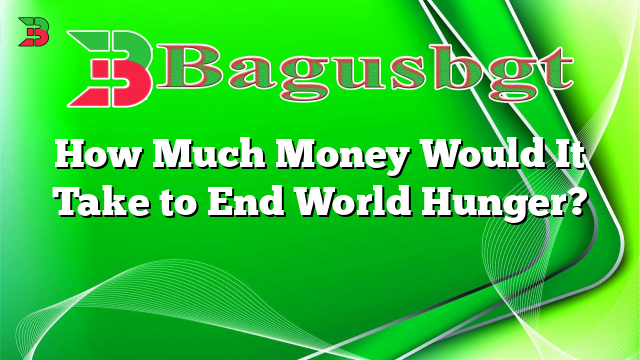Hello readers,
1. Introduction
World hunger remains one of the most pressing issues affecting humanity. Despite numerous efforts to combat it, millions of people are still suffering from chronic food shortages. One question that often arises is: how much money would it take to end world hunger?
2. The Cost of Ending World Hunger
Estimating the exact amount needed to eradicate world hunger is a complex task. However, according to a study conducted by the United Nations Food and Agriculture Organization (FAO), an annual investment of $267 billion would be required. This investment would cover various aspects such as agricultural development, social protection programs, and nutrition interventions.
3. Agricultural Development
A significant portion of the required investment would be allocated to agricultural development. This includes improving farming techniques, providing access to modern agricultural machinery, and promoting sustainable farming practices. These measures aim to increase food production, enhance crop yields, and ensure long-term food security.
4. Social Protection Programs
Social protection programs play a crucial role in addressing immediate hunger needs. These programs provide vulnerable populations with cash transfers, food vouchers, and nutritional support. By investing in social protection, governments can ensure that no one is left behind and that the most vulnerable individuals have access to sufficient food.
5. Nutrition Interventions
Another essential aspect of ending world hunger is investing in nutrition interventions. Malnutrition remains a significant contributor to hunger, especially in developing countries. By focusing on interventions such as promoting breastfeeding, fortifying staple foods, and providing access to nutrient-rich foods, the prevalence of malnutrition can be significantly reduced.
6. Advantages of Investing in Hunger Eradication
The benefits of investing in hunger eradication go beyond alleviating immediate suffering. By ensuring food security, countries can experience economic growth, improve public health, and enhance social stability. Additionally, ending world hunger aligns with the United Nations Sustainable Development Goals, contributing to a more sustainable and equitable world.
7. Challenges and Limitations
While the investment required to end world hunger is substantial, there are challenges and limitations that need to be considered. Firstly, political will and commitment are crucial in implementing the necessary policies and programs. Additionally, economic disparities and conflicts in certain regions pose significant obstacles to achieving food security for all.
8. Alternative Approaches
Aside from the estimated investment of $267 billion per year, there are alternative approaches to tackling world hunger. Some argue for a focus on improving agricultural productivity through technological advancements, while others emphasize the importance of addressing systemic issues such as poverty and inequality. These alternative approaches should be explored alongside financial investments.
9. Comprehensive Table
| Aspect | Estimated Cost |
|---|---|
| Agricultural Development | $150 billion |
| Social Protection Programs | $80 billion |
| Nutrition Interventions | $37 billion |
10. Frequently Asked Questions (FAQ)
Q: Can ending world hunger be achieved solely through financial investments?
A: Financial investments are crucial, but they need to be accompanied by comprehensive strategies addressing various factors contributing to hunger, such as poverty, inequality, and conflicts.
Q: How long would it take to end world hunger with the estimated investment?
A: The timeline for ending world hunger depends on the effectiveness of the implemented measures and the collaboration between governments, organizations, and communities. It is a long-term goal that requires sustained efforts.
Conclusion
In conclusion, ending world hunger requires a substantial financial investment of approximately $267 billion annually. This investment should be directed towards agricultural development, social protection programs, and nutrition interventions. However, it is important to acknowledge the challenges and limitations present and explore alternative approaches that complement financial investments. By prioritizing the eradication of world hunger, we can create a more just and sustainable future for all.
 Bagus Banget Kumpulan Informasi terbaru dari berbagai sumber yang terpercaya
Bagus Banget Kumpulan Informasi terbaru dari berbagai sumber yang terpercaya




